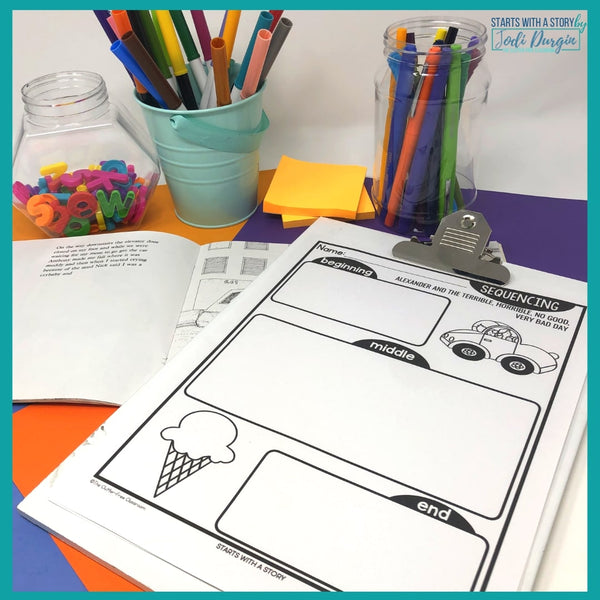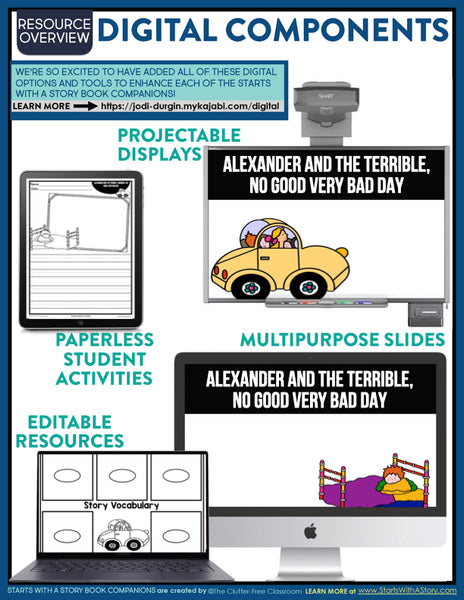Alexander and The Terrible, No Good Very Bad Day activities and lesson plan ideas
Our Alexander and the Terrible, Horrible, No Good, Very Bad Day Activities are now digital for distance learning with editable teaching slides and worksheets based on Judith Viorst’s book. Read aloud the picture book then use the printables or go paperless with Google or Seesaw to practice standards-based skills.
THIS READING UNIT FOCUSES ON USING THE MENTOR TEXT TO TEACH:
◼️ READING STRATEGIES
☐ making inferences
☐ making predictions
☐ analyzing character
☐ point of view
☐ making connections
☐ identifying genre
☐ cause and effect
☐ author's purpose
◼️ SOCIAL EMOTIONAL LEARNING TOPICS
☐ friendship
☐ making good choices
☐ conflict resolution
☐ diversity
◼️ GRAMMAR & LANGUAGE CONCEPTS
☐ common and proper nouns
☐ prefixes
☐ compound words
☐ shades of meaning
SUMMARY OF THE MENTOR TEXT:
Alexander and the Terrible, Horrible, No Good, Very Bad Day tells the story of Alexander. From the moment Alexander wakes up, everything goes wrong! He wakes up with gum in his hair, fights with his friends, and has to eat lima beans for dinner. At the end of his rough day, Alexander learns some days are just like that.
Students will make connections with Alexander as they hear about his no good day.
THIS COLLECTION OF ACTIVITIES and LESSON IDEAS INCLUDES:
➜ Comprehension Questions categorized by reading strategy; text-dependent
➜ Social-Emotional Learning guidance lesson ideas & discussion topics based on the story
➜ Vocabulary Activities with kid-friendly definitions
➜ Grammar Topics selected to align with the text
➜ Focus Sentences use the book & author's craft as a mentor text to improve writing
➜ Lesson Planner summary, background info and planning space
➜ Story Mapping Printable identify character, setting, problem and solution
➜ Making Words Activity Page use any word from the book
➜ Focus Sentence copy work, identifying elements of the sentence, rewriting)
➜ Design a New Book Cover demonstrate understanding of the text by creating an illustration
➜ Predicting Activity primary-ruled and wider-ruled versions
➜ Summarizing Somebody → Wanted → But → Then → Finally
➜ Comparing and Contrasting using a Venn Diagram
➜ Cause and Effect analyze how events affect one another
➜ Visualization illustrate visualizations from the story and support thinking with text-based evidence
➜ Making Connections identify text-to-self, text-to-text, and text-to-world connections
➜ Thematic Writing Paper Use with the Writing Prompts... Makes a Great Bulletin Board
➜ 2 Sequencing Activities First → Next → Then → Last and Beginning → Middle → End
➜ 2 Vocabulary Activities Vocabulary Booklet and Word Mapping
➜ 2 Character Trait Activities listing traits and supporting traits with text-based evidence
➜ 30 Text-Based Writing Prompts 3 prompts for each of the following types of writing:
- narrative
- persuasive / opinion
- descriptive
- expository / informative
- creative / story writing
- procedure / how-to
- list-making
- letter / postcard writing
- poem
- book reviews
INCLUDED DIGITAL ACTIVITIES:
➜ 5 Teaching Slides to use for instruction (add questions, vocabulary, instructions, etc)
➜ 15 Student Pages for use in Google™️ Classroom or as editable files to create customized printables






















